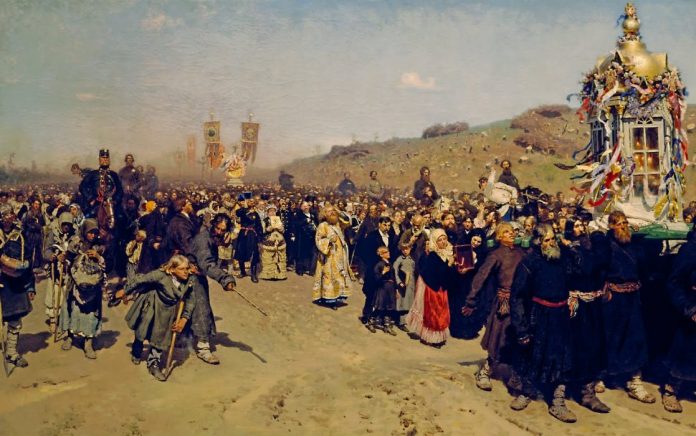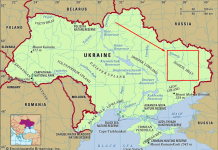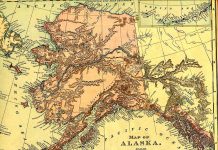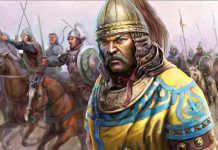“In regard to the church music of these countries, it may be observed, that the chaunting of the Cossacks dilates the breast and clears the heart of care. With a vehement love for psalmody, and a strict attention to the rules of music, they give forth, in a sweet high tone, from their very souls as it were, and from one mouth, the most delightful sounds; whereas the chaunt of the Muscovites is without science, just as it happens: it is all one to them; they find no fault; and the finest in their estimation is the low, rough, broad voice, which it is far from being pleasant to hear. As with us these gross tones are found fault with, so by them, our high intonation is deemed vicious; and they laugh at the Cossacks, and reproach them for their music, telling them that theirs is the music of the Franks and Poles…
The Russians, whenever they perceive any person guilty of either a great or a small offence, send him away instantly, with troops of other prisoners, to the land of darkness, where there is no escape, whence no return is ever granted, and where emancipation from slavery is unknown: they banish him to the province of Siberia, to be there employed in collecting sable, gray-squirrel, black-fox, and ermine furs. The distance they have to travel is a journey of three years and a half, far away to the shores of the Great Ocean, where there is no fixed abode nor permanent cultivation.
The Cossacks, moreover, all shave their beards, with the exception of a small part, and of the mustaches, which they wear long and thick; and this is the meaning of their name. But in this country of Moscow there is no such custom at all as that of shaving the beard, either among the old or the young; nor at any stage of life, from boyhood to old age. In whatever way the beard presents itself in the course of nature, so it is left to grow: and even the foreign merchants who come among them are prohibited from shaving their heads and beards in contravention of their custom, as it is a thing which they hold in the utmost abhorrence.
It is the practice with the Muscovites to name a man or a woman, not singly by their own, but by the addition of their father’s name also; and this is done even among the lowest class of labourers.
In Moldavia, Wallachia, and the Country of the Cossacks, all the Christians bury their dead, commonly, in coffins made up of boards; but here they bury them in coffins hewn out of a single piece of wood, with a lid made of another, and sloping like a roof: these are used not only for grown persons, but also for children, though no more than a day old…”
Paul of Aleppo and his father Patriarch Macarius of Antioch spent two years in Muscovy. Their impression of the two distinct realms can be summarized in the following passage recorded in 1656:
“On Friday evening we came to the bank of the river Nieper [Dnieper], opposite to the Petcherskoi Convent [Pechersk Monastery]; and sent word over to Kiov of our arrival. We had with us a letter from the Emperor to the Voivodes, enjoining them all to shew every attention to our Lord the Patriarch, and everywhere to give him the meeting. This night we slept on the bank of the river, in perfect cheerfulness and tranquillity: for, from the moment we came within sight of the Petcherskoi Convent, by the distant glittering of its cupolas, and at the first scent that reached us of these blooming lands, our souls thrilled with gladness and exultation, our hearts became expanded, and we overflowed in thanksgiving to the Lord our God. During these two years in Muscovy, a padlock had been set on our hearts, and we were in the extremity of narrowness and compressure of our minds; for in those countries no person can feel anything of freedom or cheerfulness, unless it be the native population. Any one like ourselves, though he became sovereign of the whole territory, would never cease to have a disturbed mind, and a heart full of anxiety. The country of the Cossacks, on the contrary, was like our own country to us, and its inhabitants were to us boon companions and fellows like ourselves.”
Anout the title image. The Religious Procession in Kursk Governorate is a large oil on canvas painting by the realist painter and sculptor Ilya Repin (1844–1930). Completed between 1880 and 1883, the work shows a seething, huddled mass attending the annual crucession (cross-carrying Eastern Orthodox religious procession)…
The procession is led through a dusty landscape by robed, Orthodox priests holding icons, festoons and banners over their heads. Behind them follow a crowd mostly of peasants, but ranging from beggars and disabled people, police and military officers to figures from the provincial elite. Religious Procession led to controversy when first exhibited due to the icon being held by a man who appears to be drunk.
The writer Richard Brettell summarised the painting as “a sort of summa of Russian society, diverse members of which move uneasily but restlessly together down a dusty path through a naked landscape towards a future that cannot be seen even by the painter.”
Critic Christian Brinton saw a mixture of “fat, gold-robed priests, stupid peasants, wretched cripples, cruel-mouthed officials, and inflated rural dignitaries”.
Repin is less sympathetic to the privileged members of the procession, whom he depicts as uncaring and indifferent to their struggling fellow travelers. The disenfranchised members of Russian society are represented by, amongst others, the old and young peasants in the left foreground (serfdom in Russia had been abolished in 1861).
The painting was bought by the leading Russian collector Pavel Tretyakov for a record 10,000 roubles, but Tretyakov wanted Repin to replace the maids carrying the empty icon-case with “a beautiful young girl, exuding spiritual rapture”. Repin refused.
Religious procession in present-day Russia. Did anything change in 200 years? Repin was a genius.
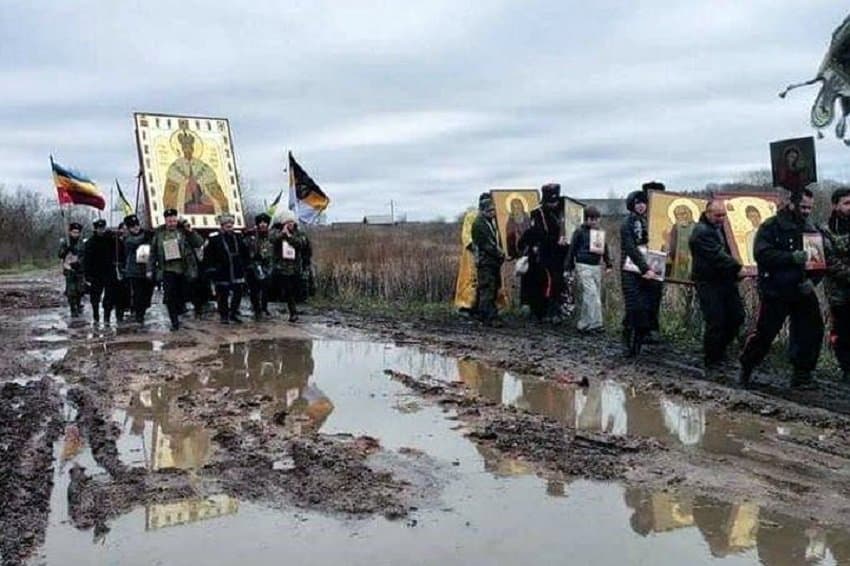
Difference between ‘Russians’ and Ukrainians in the 19th century by Ivan Bunin >



